Pennsylvania is home to many species of bees and wasps, some of which can deliver a painful sting. This article will explore Pennsylvania’s five most common stinging insects and how to coexist peacefully with them. We’ll also examine the Schmidt Pain Index—a scale used to rate the level of pain inflicted by different insect stings—and discuss some practical tips for avoiding stings and protecting these critical members of our ecosystem.
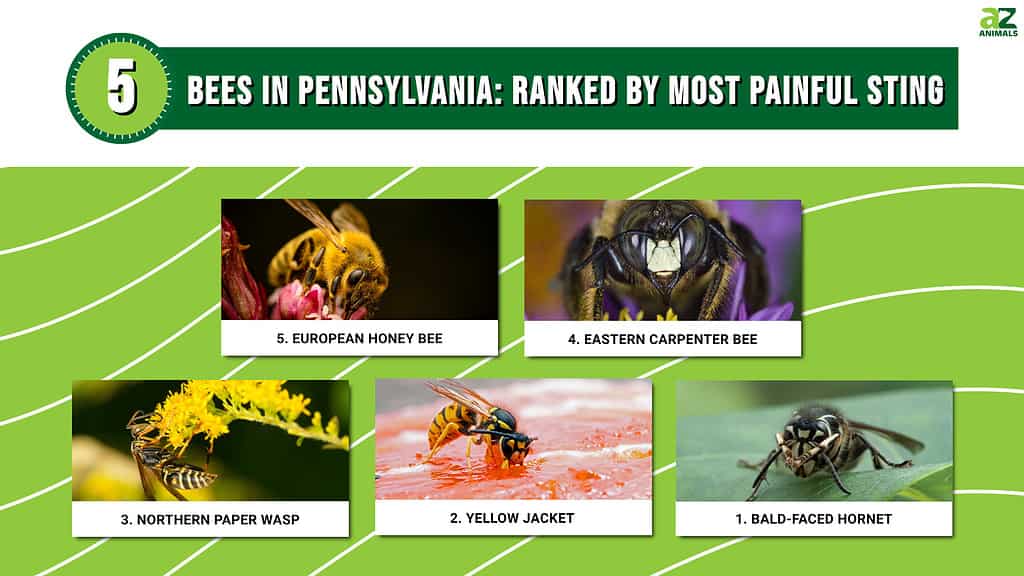
European Honey Bee (Apis mellifera): Pain Rank — 3
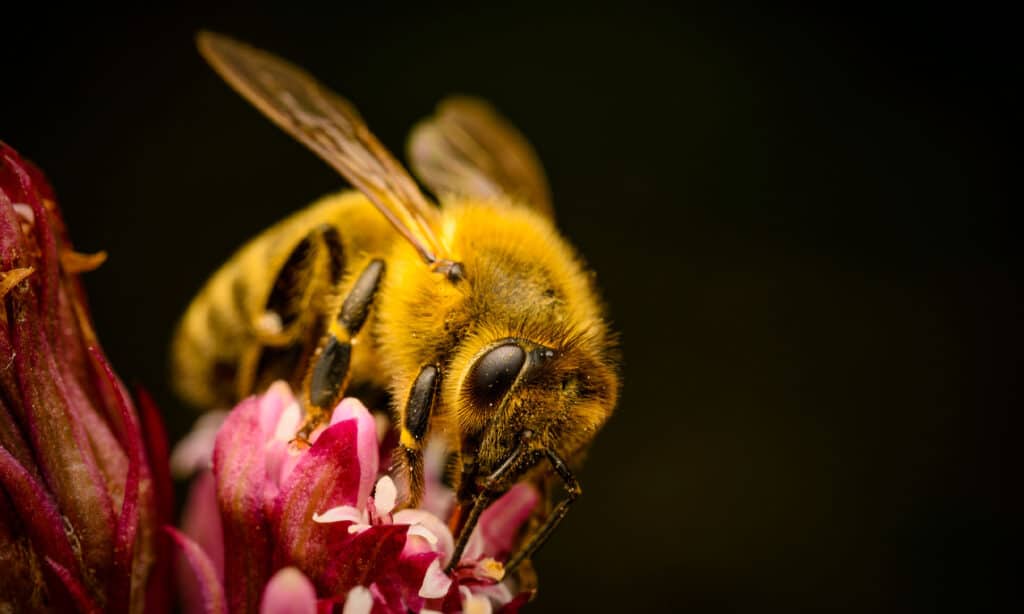
©iStock.com/Jan Rozehnal
Let’s kick off our list with the famous European honey bee. These little workers are vital for pollination, agriculture, and, of course, honey production. You’ll often find them in gardens and orchards, drawn to the beautiful flowers.
Now, let’s talk about their sting. On the Schmidt Pain Index, the European honey bee scores a 3, the highest on our list. The sting is often described as a “burning, throbbing or throbbing pain that lasts several minutes.” However, honey bees die after stinging, so they only use their sting as a last resort to defend their hive.
Eastern Carpenter Bee (Xylocopa virginica): Pain Rank — 2.5
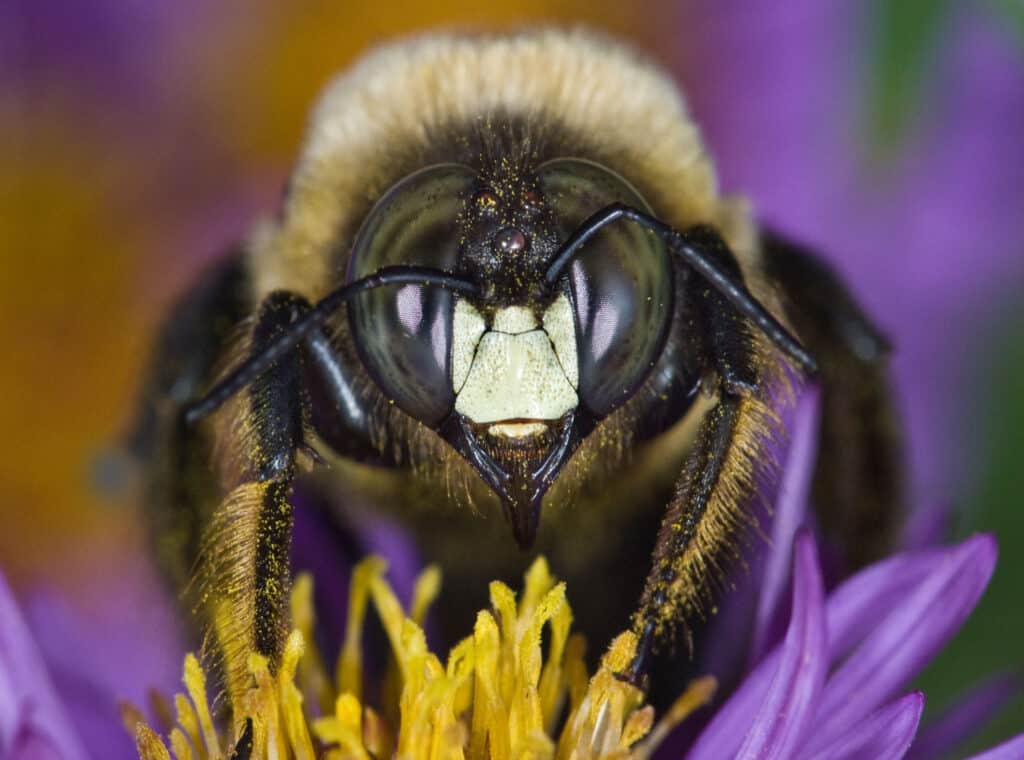
Carpenter bees have large eyes and a glossy, hairless abdomen.
©Gerry Bishop/Shutterstock.com
Next up is the Eastern carpenter bee. Often mistaken for bumblebees, these large, black, and yellow bees have a unique nesting habit: they bore holes into wood to create their homes. They’re essential pollinators for various plants, contributing to the ecosystem’s health.
Regarding their sting, Eastern carpenter bees rank 2.5 on the Schmidt Pain Index. The pain is described as a more intense and lasting version of the honey bee sting, with a burning sensation that lasts longer. But fear not; these bees are not aggressive and will only sting if provoked.
Northern Paper Wasp (Polistes fuscatus): Pain Rank — 2
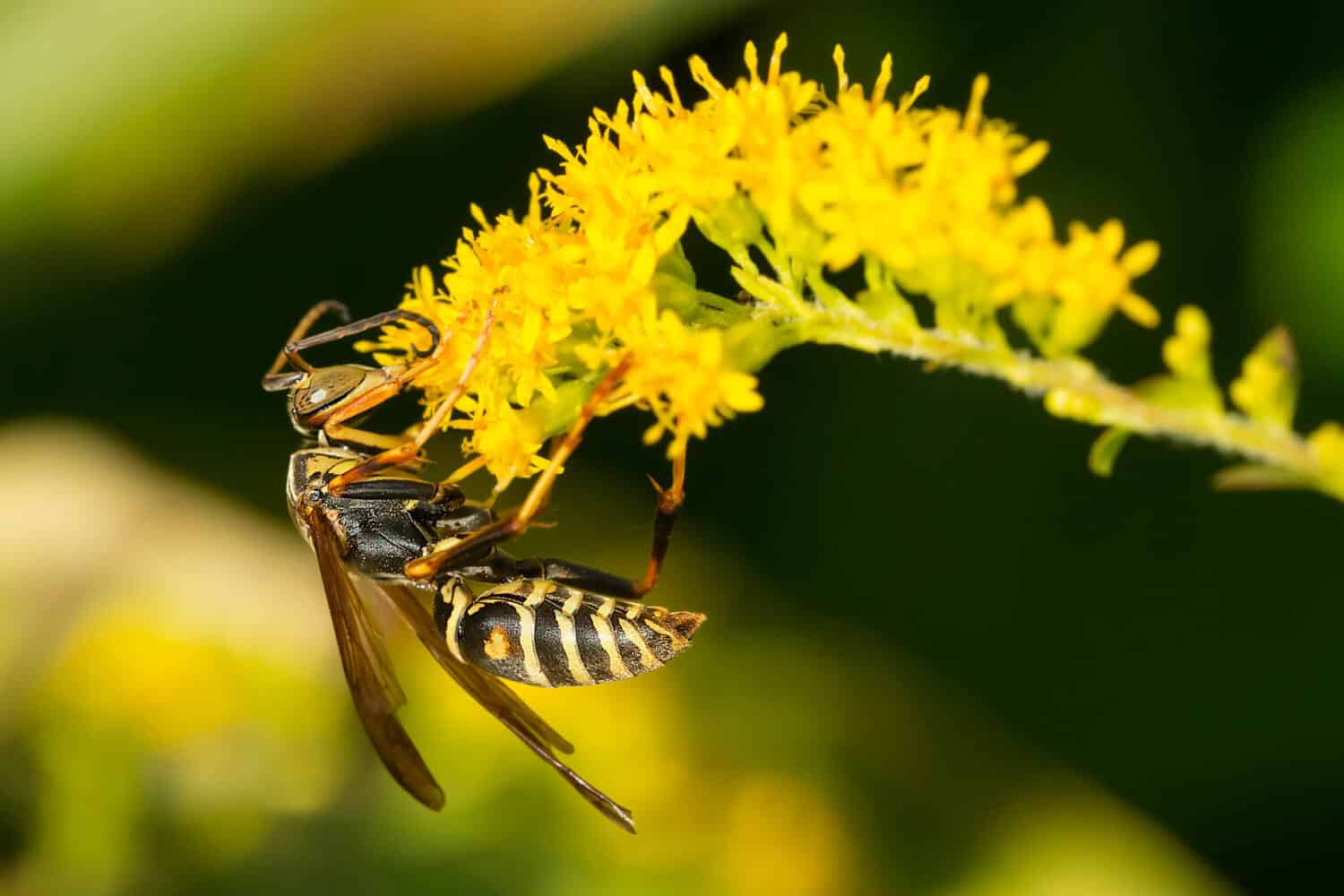
Image: Paul Reeves Photography, Shutterstock
©Paul Reeves Photography/Shutterstock.com
Although not a bee, the Northern paper wasp deserves an honorable mention on our list. Known for their umbrella-shaped nests made of chewed wood fibers, these insects are essential predators in our ecosystem, controlling the population of other insects.
The Northern paper wasp’s sting ranks a 2 on the Schmidt Pain Index. The sting is “sharp and sudden, similar to a hot needle piercing the skin.” The pain usually subsides within a few minutes. While paper wasps aren’t overly aggressive, they will defend their nests if threatened.
Yellow Jacket (Vespula spp.): Pain Rank — 2
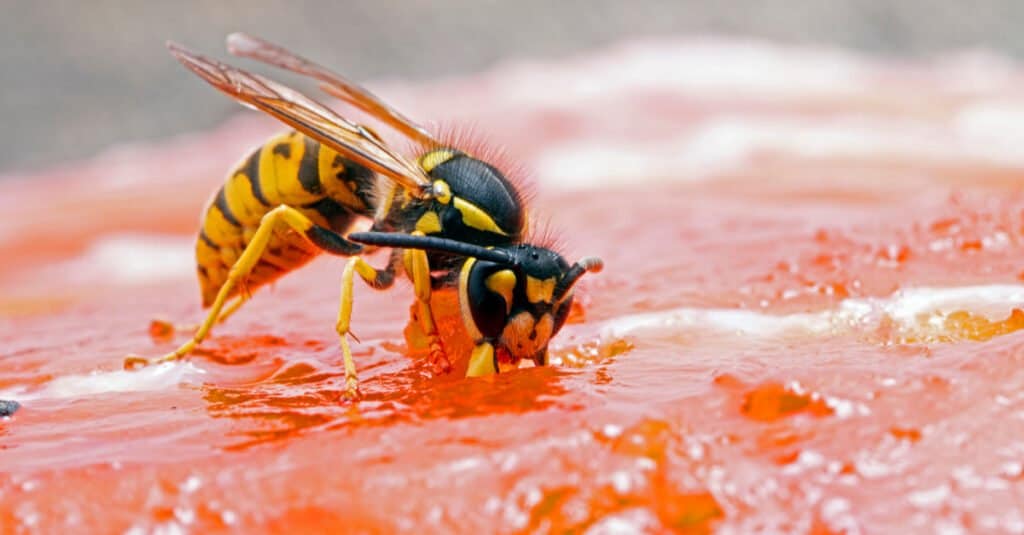
©Ernie Cooper/Shutterstock.com
Yellow jackets are familiar in Pennsylvania, with their distinctive black and yellow striped bodies. These social wasps are essential predators, feeding on other insects and helping maintain a balanced ecosystem.
Yellow jackets also rank a 2 on the Schmidt Pain Index, describing a sting as “instant, sharp pain with a burning sensation.” These wasps can be more aggressive than other stinging insects on our list, especially when defending their nests. Exercise caution around their nests, allowing them space to avoid painful encounters.
Bald-Faced Hornet (Dolichovespula maculata): Pain Rank — 2

Hornets are social wasps that build communal nests by chewing wood to create a sticky thin pulp.
©Ernie Cooper/Shutterstock.com
Last but not least is the bald-faced hornet. These insects are a type of yellow jacket, characterized by their black bodies and white markings. They’re known for their large, football-shaped nests in trees or shrubs.
The sting of a bald-faced hornet ranks a 2 on the Schmidt Pain Index, and the pain has been described as “intense and immediate, with a lingering burning sensation.” Like their yellow jacket cousins, bald-faced hornets can be aggressive when their nest is disturbed, so it’s best to keep your distance and admire these fascinating creatures from afar.
Tips For Avoiding Stings And Coexisting With Bees And Wasps
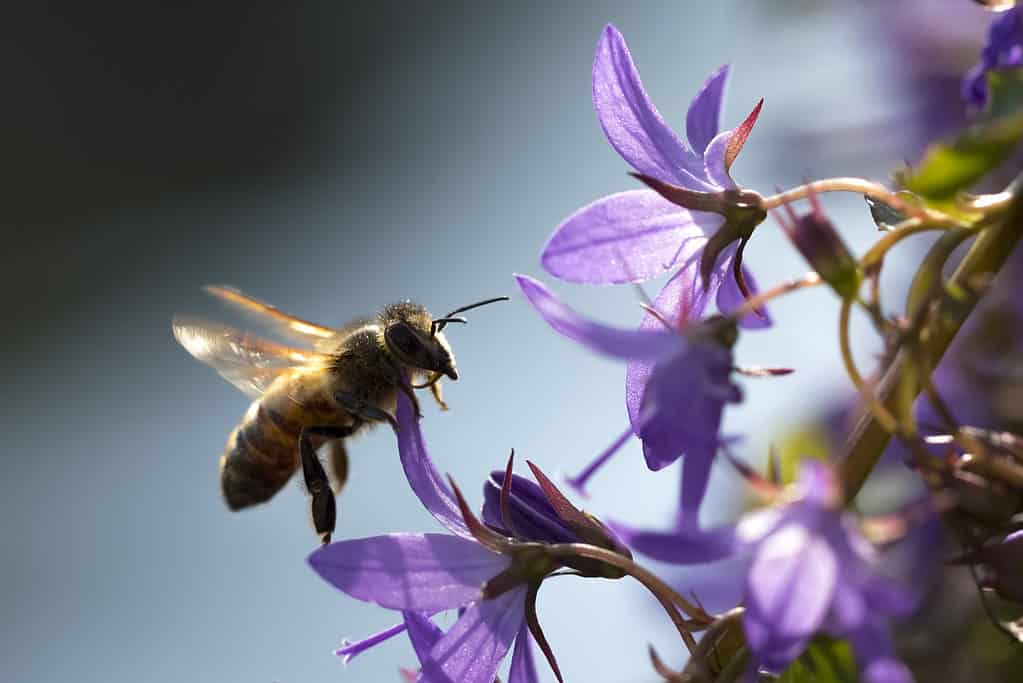
Curious to learn about Georgia’s state insect? Keep reading to learn more about this unique-looking insect!
©SanderMeertinsPhotography/Shutterstock.com
Now that we’ve explored the stinging insects of Pennsylvania and their respective pain rankings, let’s discuss some practical tips for avoiding stings and coexisting peacefully with these essential members of our ecosystem.
Be mindful of your surroundings: When outdoors, especially in areas with abundant flowers, trees, or shrubs, be aware of bees and wasps. Look out for nests and give them plenty of space to prevent unwanted interactions.
Don’t Swat At Them
If a bee or wasp is flying around you, it’s best to remain calm and avoid swatting at them. Sudden movements can provoke stinging insects and make them feel threatened.
Avoid Wearing Strong Scents
Perfumes, colognes, and other strong scents can attract bees and wasps. Opt for unscented products when spending time outdoors, especially in areas where these insects are prevalent.
Dress Wisely
When venturing into areas with high bee and wasp populations, wear light-colored, long-sleeved clothing to minimize the risk of stings. Dark or brightly colored clothing can attract these insects, increasing the likelihood of being stung.
Keep Food Covered
If you’re having a picnic or outdoor gathering, keep food covered to avoid attracting yellow jackets and other wasps. These insects are particularly drawn to sugary and protein-rich foods.
Conclusion
Though the stings of these five insects native to Pennsylvania can be uncomfortable, it is essential to recognize their invaluable roles in our ecosystem. Bees and wasps are vital pollinators and predators for maintaining a healthy environment.
By learning more about these fantastic creatures and taking precautions to avoid stings, we can respect and protect their populations while enjoying the great outdoors in Pennsylvania. So, the next time you’re out and about, take a moment to appreciate these incredible insects and their unique place in our world.
Summary Of The 5 Bees
| Rank | Bee | Pain Rank |
|---|---|---|
| 5 | European Honey Bee | 3 |
| 4 | Eastern Carpenter Bee | 2.5 |
| 3 | Northern Paper Wasp | 2 |
| 2 | Yellow Jacket | 2 |
| 1 | Bald-Faced Hornet | 1 |
The photo featured at the top of this post is © SanderMeertinsPhotography/Shutterstock.com
Thank you for reading! Have some feedback for us? Contact the AZ Animals editorial team.







